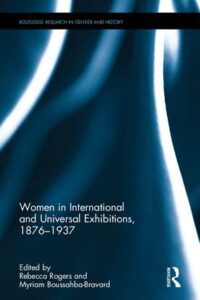
Women in International and Universal Exhibitions, 1876–1937
Publication | Table des matières | Critiques
Résumé
This book argues for the importance of bringing women and gender more directly into the dynamic field of exposition studies. Reclaiming women for the history of world fairs (1876-1937),it also seeks to introduce new voices into these studies, dialoguing across disciplinary and national historiographies.
From the outset, women participated not only as spectators, but also as artists, writers, educators, artisans and workers, without figuring among the organizers of international exhibitions until the 20th century. Their presence became more pointedly acknowledged as feminist movements developed within the Western World and specific spaces dedicated to women’s achievements emerged.
International exhibitions emerged as showcases of “modernity” and “progress,” but also as windows onto the foreign, the different, the unexpected and the spectacular. As public rituals of celebration, they transposed national ceremonies and protests onto an international stage. For spectators, exhibitions brought the world home; for organizers, the entire world was a fair.
Women were actors and writers of the fair narrative, although acknowledgment of their contribution was uneven and often ephemeral. Uncovering such silence highlights how gendered the triumphant history of modernity was, and reveals the ways women as a category engaged with modern life within that quintessential modern space—the world fair.
Table des matières
Introduction: Positioning Women in the World Fairs, 1876-1937
[Myriam Boussahba-Bravard and Rebecca Rogers]
Part I: Exhibiting Women: Collectors, Artists and Students
1. Expositions and Collections: Women Art Collectors and Patrons in the Age of the Great Expositions
[Julie Verlaine]
2. Unpretentious Paintings: Mexico’s National School of Fine Arts’ Women Students at the 1893 Chicago Columbian Exposition
[Ursula Tania Estrada]
3. Inserting the Personal in the International: The American Girl at the 1900 Paris Exposition
[Linda Kim]
Part II: Promoting Women: Professionals, Workers and Organizers
4. “After Mature Deliberation”: Women Lawyers’ Infiltration of the 1893 World Columbian Exposition
[Gwen Jordan]
5. International Expositions and the Rewriting of Portuguese Women’s History (1889-1908)
[Teresa Pinto]
6. A “Reason to Act, an Ideal to Strive Towards”: Women as Intellectual Organizers at the Paris Exhibition of 1900
[Anne R. Epstein]
Part III: Staging Otherness: Women on and from the Margins
7. African American Women’s Voices at the 1893 Chicago World Fair
[Claudine Raynaud]
8. Between Knowledge and Spectacle: Exotic Women at International Exhibitions (Paris, 1889 and 1900)
[Christiane Demeulenaere-Douyère]
9. International Activism After the Fair: New South Wales, Utah, and the 1893 World’s Columbian Exhibition
[James Keating]
Part IV: Mobilizing Women: National, International, and Transnational Feminism(s)
10. Rendezvous at the Expo: Building a Franco-American Women’s Network, 1889-1893-1900
[Karen Offen]
11. Forging the Transnational out of the International: Feminist Internationalism at World’s Fairs and International Exhibitions
[Tracey Jean Boisseau]
12. French Women at the Paris 1937 Exhibition: One Step Forward, Two Steps Back?
[Siân Reynolds]
Critiques
- “The book … focuses on the place that women occupied in the preparation of world fairs as well as on the influence the fairs then had on their activities. This theme offers a welcome addition to the considerable scholarship on international and universal exhibitions… [The volume] in particular draws attention to a wide variety of archives as each article ends with a list of sources and bibliography … testimony to the editors desire to highlight the archives allowing us to rewrite the history of exhibitions.”
— Marie Chessel, Images du travail, Travail des images (translated from French) - “The volume’s interest in women’s participation and the gendered dynamics that shaped exhibitions brings to light hitherto neglected issues and opens new perspectives both for women’s history and for research on exhibitions.”
— Júlia Garraio, ex aequo ((translated from Portuguese) - “The plurality of themes addressed in this richly documented volume contributes to a variety of historiographies and disciplines. Half of the essays address more than one universal exhibition. We hope, with the editors, that this important book will inspire further investigations revealing the fruitful intersection of histories of women and universal exhibitions.”
— Anne Cova, Faces de Eva (translated from Portuguese) - “A vast historiography already exists on international and universal exhibitions but little scholarship addresses specifically women’s participation despite their presence in the sources and the archives. Myriam Boussahba-Bravard and Rebecca Rogers have chosen to give voice to largely neglected women’s voices, to bring to light forgotten stories and, especially, to provoke an interdisciplinary and transnational dialogue among the authors that echoes that of the female participants in the exhibitions.”
— Muriel Pécastaing-Boissière, Revue LISA/LISA ejournal (translated from French) - “This important volume from an authoritative international team of authors sheds significant new light on the comparative development of post-war Conservatism in the western world.”
– Stuart Ball, Professor Emeritus, University of Leicester, UK - “The rich essays collected in this illuminating volume show that the rise of right-wing politics in the United Kingdom, the United States, and France since the 1970s was a remarkably transnational phenomenon. As they attacked social democracy and cultural pluralism, right-wing movements borrowed ideas, visions, vocabularies, and tactics from each other, adapting them to their own national idioms and using advances in one country to win advances elsewhere. Anyone interested in confronting the problems that have proliferated in the wake the right’s reconfiguration of politics – surging inequality, belligerent ethno-nationalism, worker disempowerment and insecurity, and lost faith in the capacity for democratic self-government – has much to learn about the origins of these problems from this important book.”
– Joseph A. McCartin, Georgetown University, USA, author of Collision Course
